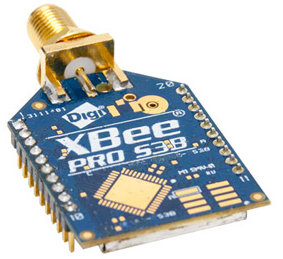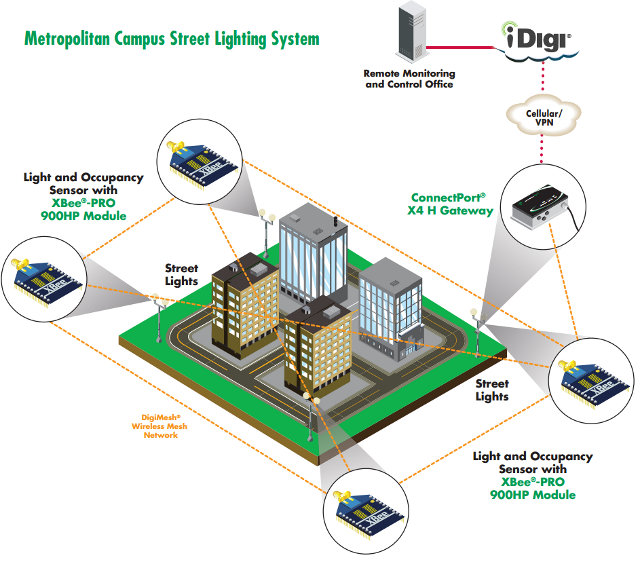Digi International has recently announced the XBee-PRO 900HP RF embedded module based on ADF7023 transceiver and Energy Micro Cortex-M3 EFM32G230 MCU @ 28 MHz. The company claims the module supports a line-of-sight range of up to 45 km with a high-gain antenna and data rates of up to 200 Kbps.45 km is not quite enough to communicate in space (100 km), but that’s still a pretty good range. Indoor / urban range is up to 600m.
 Here are the hardware specifications of XBee-PRO 900HP module:
Here are the hardware specifications of XBee-PRO 900HP module:
- Processors – ADF7023 transceiver and Cortex-M3 EFM32G230 @ 28 MHz
- Frequency Band – 902 to 928 MHz, software selectable channel mask for interference immunity
- Antenna Options – Wire, U.FL and RPSMSA
- RF Data Rate – 10 Kbps or 200 Kbps
- Indoor/Urban Range – Up to 2000 ft (610 m)
- Outdoor/ Line-Of-Sight Range – Up to 9 miles (14 km) w/ dipole antenna; Up to 28 miles (45 km) w/ high-gain antenna
- Transmit Power – Up to 24 dBm (250 mW) software selectable
- Receiver Sensitivity – -101 dBm @ 200 Kbps, -110 dBm @ 10 Kbps
- Data Interface- UART (3V) and SPI
- GPIO – Up to 15 Digital I/O, 4 10-bit ADC inputs, 2 PWM outputs
- Networking Topologies – DigiMesh, Repeater, Point-to-Point, Point-to-Multipoint, Peer-to-Peer
- Spread Spectrum – FHSS (Software Selectable Channels)
- Supply Voltage – 2.1 to 3.6 VDC
- Power – Transmit Current – 215 mA, Receive Current – 29 mA and Sleep Current 2.5 uA
- Regulatory Approvals:
- FCC (USA)
- IC (Canada)
- C-Tick (Australia)
- Anatel (Brazil) – Pending
The module appears to consume very little power, as transmit current is 215 mA and sleep current 2.5 uA, which means that with 15 minutes interval data, 2 AA batteries could, in theory, last a year (Source: Twitter). Firmware can be updated over-the-air (OTA) via other XBee-PRO 900HP modules or iDigi Device Cloud service. The XBee-PRO 900HP modules does not require no programming and can be configured via AT command set or Digi’s X-CTU software.
The diagram below shows an example use in a campus to control the street lights using the RF modules and light and occupancy sensors. Data is then transmitted to a home energy gateway, which then sends data back to a remote monitoring and control office via a cellular or VPN connection.

There are 12 modules available (configuration depends on the data rate, antenna option and country) with price ranging between $39 and $42. Digi also provide the 900 MHz XBee-PRO® DigiMesh 900 development kit ($299) which include 4 XBee-PRO DigitMesh modules (1x w/ RPSMA antenna, 1x w.U.fl connector and 2 w/ a wire antenna), 4x USB development board and USB cables, 2x 900 MHz RPSMA antennas, and 2 power adapters. This kit can allow you to setup a peer-to-peer mesh network with the DigiMesh protocol (peer-to-peer networking topology).
Further information is available on Digi XBee-PRO 900HP page.

Jean-Luc started CNX Software in 2010 as a part-time endeavor, before quitting his job as a software engineering manager, and starting to write daily news, and reviews full time later in 2011.
Support CNX Software! Donate via cryptocurrencies, become a Patron on Patreon, or purchase goods on Amazon or Aliexpress





I think illegal use of such funds without the consent of
@Alexufo
This looks like “Google Translate” text, but I think I understand. Yes, you need to make sure it’s legal in your country. It should be OK in the US, Canada, Australia and Brazil (since they implicitly mention approval), but I’m not sure if it’s legal in other countries.
@cnxsoft
Yes. Its goolge). I try to cheat. I am Sorry, i didn’t see “900Mhz”. Its frequency like frequency of radio phones. Fist of all i need to think twice, before writing)
@Alexufo
That’s OK, mainly people use Google Translate when English is not one of their main language. The only problem is that sometimes it’s really difficult to understand. 🙂
But if it is 900 MHz (i.e. the same band as GSM), it must be regulated in some ways to avoid interfering with mobile communication. Not sure, sorry, I don’t really much about this.
250 mW on the 915 Mhz ISM band might be too powerful for a short range device in the EU.
From wikipedia: “Note that the 915 MHz band should not be used in countries outside Region 2, except those that specifically allow it, such as Australia and Israel, especially those that use the GSM-900 band for cellphones.”
Region 2 covers the Americas, Greenland and some of the eastern Pacific Islands.
http://en.wikipedia.org/wiki/ISM_band
@jeremy
Thanks for the info Jeremy.
You must be right about Europe, since it’s not for sale in Digi Europe store, and they only have “SKU” for North America and Australia.
@cnxsoft
Woohoo! There are some advantages to being geographically isolated 🙂